#triakis semifasciata
Explore tagged Tumblr posts
Text
Critter fact #143:
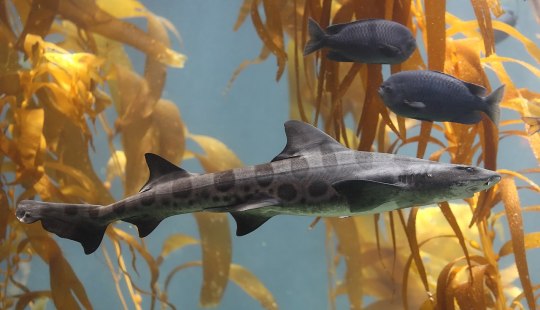
Leopard sharks (Triakis semifasciata) are often found in sandy bottoms or muddy bays and estuaries in the west coast of North America. Their distinctive appearance allows for easy identification within their range.
#critter facts#fish#fish facts#sharks#Shark facts#Triakis semifasciata#Leopard shark#cartilaginous fish
36 notes
·
View notes
Text
The leopard shark, Triakis semifasciata, is often traded as a juvenile on dealers lists. I have also seen babies on sale, in a tropical reef tank, at a UK vendor in Salford. This is a dilemma, because T. semifasciata is not a tropical species, and will not do very well in tropical aquariums, a sad situation that is not really conveyed to the shark admiring public. The impressive maximum length of this species, is around 2 meters or 6 feet, and the active, roving habits of this beautiful shark, are also impediments to its humane care in the home. A more common length is 1.6 meters, or over 5 feet, but this is clearly too large for ordinary private aquariums.
T. semifasciata is a shark of the shallow depths along western North America. It is gregarious by nature, and large schools of leopard sharks are often encountered in bays, lagoons, and estuaries. This species is associated with both sandy and muddy bottoms, and rockier areas near kelp beds and rocky reefs. It is present in estuaries where the salinity approaches that of seawater, and the temperature there is stable, making these environments suitable for the gravid females and newborns. This species is reported from areas where the salinity is as low as around 20 ppt, or a specific gravity of 1.015, and rarely even 14 ppt, though salinities below 18 ppt are known not to be well tolerated by this species when it is for prolonged periods.
T. semifasciata is one of the so-called triakid sharks, although in reality the 'triakids' are merely a semi-natural or paraphyletic grouping, within the group of sharks known as carcharhiniforms. That is to say, Triakis and other so-called 'triakids' may be no more closely related to one another, than they are to the requiem sharks, the hammerhread sharks, or the tiger shark.
Wild T. semifasciata fortunately have wide environmental tolerances, and they can experience summer temperatures of 24 to 26 degrees centigrade, but not on a permanent, year round basis. A study of their metabolism found them adapted to tolerate temperatures of around 24 degrees, which befits their foraging in warm, very shallow environments during the summer months. Juvenile T. semifasciata, at least, prefer a cooler ambient water temperature of 17 or 18 degrees centigrade.
Mature individuals were found to prefer temperatures of 22 to 24 degrees, when they are aggregating in the summer and autumn seasons. At these higher temperatures, T. semifasciata are better able to metabolize their food, which is why they congregate and forage for benthic prey nearshore, during warm hours of the day. Sympatric rays with similar foraging habits must retreat to cooler depths, so that they may thermoregulate properly.
Even tropical marine aquaria have trouble with overheating in temperate summers, so temperate marines will also suffer in the heat. Unless the aquarist wishes to invest in an expensive chilling system, the tank or pool needs to be maintained in a cool, well insulated, and probably air conditioned room. The aquarium decor should not clutter their roving space, so as to become an obstacle, and the filtration needs to be of an extremely high capacity.
With that said, if the basic requirements for this shark are met, it proves very hardy in public and private settings. This is why the species is now a popular species in zoo exhibit, often in simulated kelp forests with artificial fronds, far distant from their native range in the North Pacific. Unlike some sharks, T. semifasciata is quite non-aggressive, and not prone to attempt predation on tankmates of large size, which contributes to its appeal.
T.semifasciata requires a tank or pool with a footprint at least 6 times by 4 times its own length. Accommodating juveniles of this species is therefore feasible, but sadly, the adults need more space than the entire ground plan of many homes. On the plus side, their teeth belong to a piercing guild, useful for seizing relatively small prey moreso than ripping flesh. This is why T. semifasciata will not hurt large fish or elasmobranchs, though matters of size are relative, and their natural diet upon maturity includes fishes up to a size of 50 centimeters, or 20 inches, including flatfishes and surfperches. This is about 1/3 of their own length.
They also prey on a variety of other animals, and their broad diet actually varies with the growth stage and the time of the year. A with varying frequencies and proportions that depend on the size of the individual, T. semifasciata consumes such prey as crabs, shrimps, grunion eggs, annelids, squid, clams, and sea urchins. Feeding these versatile sharks on dead prey is fortunately easy, and their natural diet can easily be simulated, by purchases made on a trip to the fishmonger, or even the supermarket.
#Triakis semifasciata#temperate marine#brackish#leopard shark#tankbusters#aquarium sharks#misunderstood sharks
0 notes
Note
more mer hermit?
Port Jackson or tawny nurse mumbo?
Leopard shark Grian?
banded bamboo shark/blacktip reef shark Gem?
of course, it's mer-may afterall!



#still in the brainstorming phase of drawing mermaids so heres some fullbody comps as i try and figure out some sort of consistency#also im assuming 'leopard shark grian' is talking about Stegostoma fasciatum (leopard in aus / zebra in us)#and not Triakis semifasciata (zebra in aus / leopard in us)#the common names are so confusing lmao#mumbo jumbo#grian#geminitay#hermitcraft#my art#rough work#funny enough i did have picks for these three specifically already (dumbo octopus/some species of wrasse/tiger shark)#but it was super fun drawing them as aus sharks! sharks FTW!!!
161 notes
·
View notes
Text
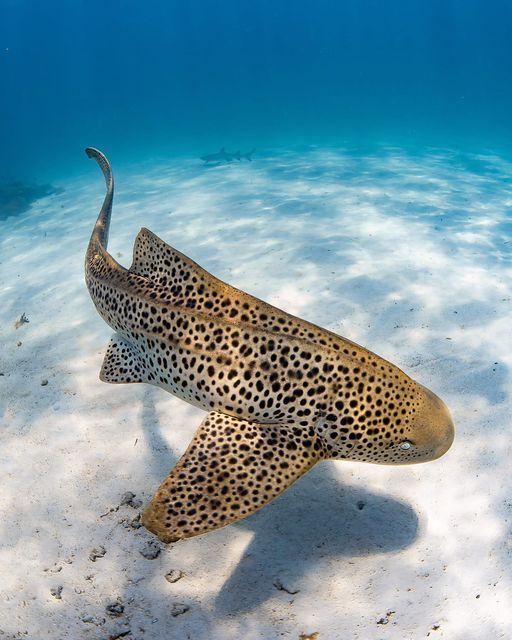
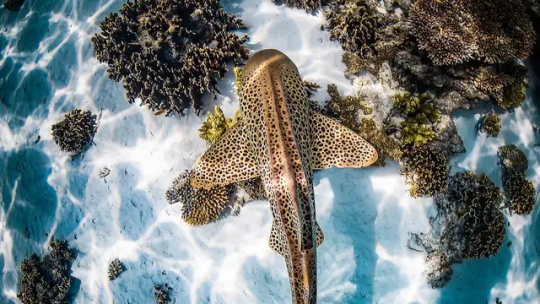
Zebra Sharks (Stegostoma tigrinum), family Stegostomatidae, order Orectolobiformes, off the coast of WA, Australia
ENDANGERED.
This shark gets its name from the appearance of the juveniles, which are striped.
In parts of its range, it is sometimes called the Leopard Shark. There is, however, another shark referred to commonly as the Leopard Shark. Triakis semifasciata, a kind of houndshark, that lives along the Pacific Coast of North America from Oregon to Mexico.
photograph by Brooke Pyke
#shark#elasmobranch#fish#stegostoma#stegosomatidae#orectolobiformes#ocean#australia#animals#nature#ichthyology
1K notes
·
View notes
Text
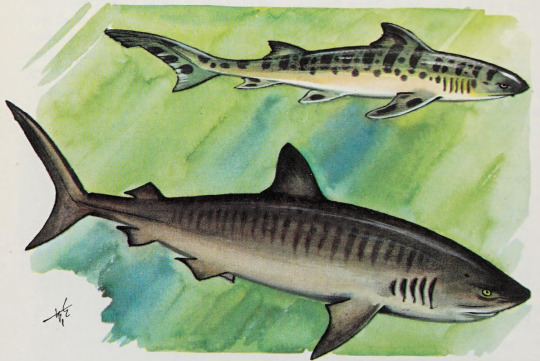
Leopard shark (Triakis semifasciata), Tiger shark (Galeocerdo cuvier)
Fishes of the World. Written by Hans Hvass. Illustrated by Wilhelm Eigener. Originally published in 1964.
Internet Archive
212 notes
·
View notes
Text
Daily Shark Fact - 5/27/2025
Today's shark is the leopard shark!

The basics: the leopard shark (Triakis semifasciata) is a species of houndshark that can be found in large schools off the coast of its range along the Pacific coast of North America. They are often found over sandy or muddy flats near kelp beds and reefs, whey they hunt for clams, crabs, and fish eggs along the sediment between actively hunting for bony fish. Their schools have been known to mingle with other species of similarly-sized shark, including some smoothounds and the spiny dogfish!
Conservation status: least concern. Though the leopard shark is commercially fished for its meat and for the aquarium trade, and populations are highly susceptible to local depletion due to a slow reproduction rate, leopard sharks are a success story for sustainable fishing practices. Their populations were once at risk, but with the help of regulations have bounced back and are still on the rise.
Today's fun fact: because leopard sharks are strongly schooling species and tend to stay with their school in the same areas, there are noticeable demographic differences between populations! Their behaviors will also vary by location as different groups have different preferred strategies for following the tides for food or migrating up and down the water column based on time of day.

#shark facts#sharks#daily shark fact#marine biology#marine life#ground sharks#houndsharks#leopard sharks
15 notes
·
View notes
Note
shark list…?
SHARK LIST!!!!!
This is another list that's based mostly off vibes and aesthetic rather than any deep analytical reasons, though I do have some deeper reasons for these choices but let's just focus on vibe for today
RAPH: Tiger shark (Galeocerdo cuvier)

LEO: Common thresher shark (Alopias vulpinus)

DONNIE: Scalloped hammerhead (Sphyrna
lewini)
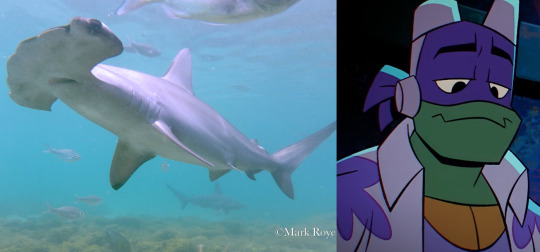
MIKEY: Leopard shark (Triakis semifasciata)
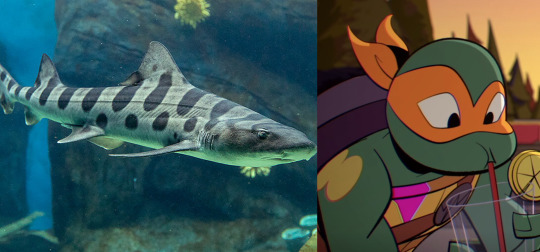
BONUS
APRIL: Epaulette shark (Hemiscyllium ocellatum)
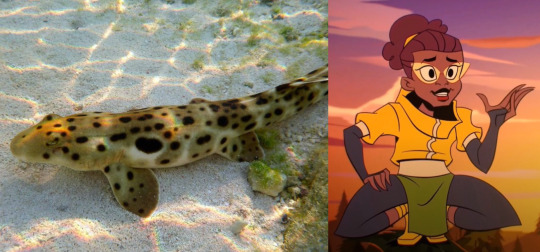
SPLINTER: Spotted wobbegong (Orectolobus maculatus)
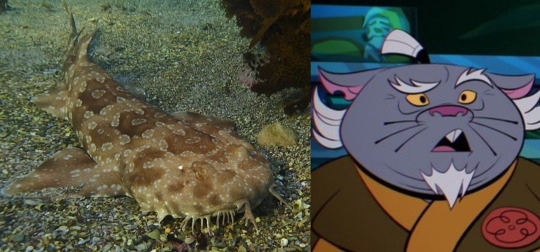
DRAXUM: Horned shark (Heterodontus francisci)
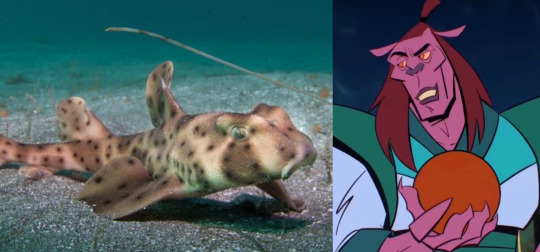
CASEY JONES: Sandbar shark (Carcharhinus plumbeus)
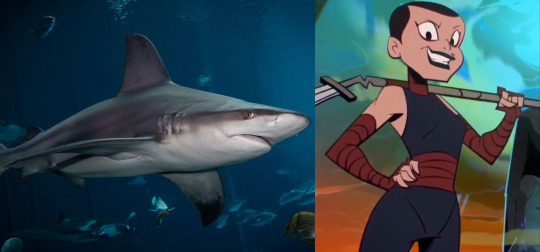
CASEY JR: Blacktip reef shark (Carcharhinus melanopterus)
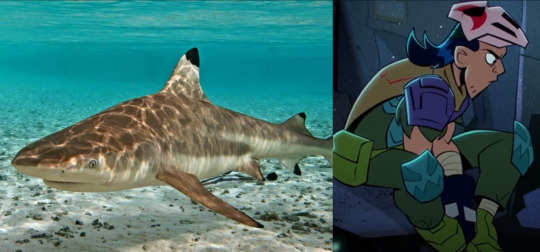
I promise I wasn't ignoring this ask I was just thinking very deeply about the answer to this list for not only the rise brothers but the direct family ensemble and wanted it to be the best list that I could make (tbh I made this list more for myself and is super based off my personal opinions. I'm a huge shark fan and was really excited to get this ask so I wanted it be a list I was confident in)
#rottmnt#rise of the tmnt#rise mikey#rise leo#rise donnie#rise raph#rise splinter#rise april#rise casey jones#rise casey jr#sharks#tw shark#peachmoths ask tag#fun fact like five of the sharks on this list are sharks i have at my work LMFAO#oh and if you were wondering my top 5 fave sharks list it goes whale shark leopard shark nurse shark bamboo shark and black tip reef shark#i really like carpet sharks can you tell lmfaooooo
187 notes
·
View notes
Text
hey. weirdly specific question. does anyone have a microscope image of blood from a zebra shark with an infection? doesn't matter what infection, or if the shark is stegostoma fasciatum or triakis semifasciata.
#it's for a thing I'm writing#this seems like a question for Reddit maybe but I refuse to touch that website#shark#marine biology
8 notes
·
View notes
Text
Since I'll be doodling and posting a number of them for mermay, here's my current species list for my HXH mer au! (not necessarily siren/selkie specific, just merfolk in general)
MAIN FOUR
Gon - sailfish [Istiophorus Albican] (selkie - Caribbean monk seal [Neomonachus Tropicalis])
Killua - (albino) leopard shark [Triakis semifasciata] (selkie - leopard seal [Hydrurga leptonyx])
Leorio - nurse shark [Ginglymostoma cirratum]
Kurapika - thresher shark? Or spinner dolphin (selkie - northern fur seal)
ZOLDYCKS (and butlers)
Illumi - gulper eel [Eurpharynx pelecanoides]
Kalluto - tripod fish [Bathypterois grallator]
Alluka - box jellyfish? Or flamboyant cuttlefish [Ascarosepion pfefferi]
Milluki - Beluga [Delphinapterus leucas]
Kikyo - lion’s mane jellyfish [Cyanea capillata]
Silva - (albino) great white shark [Carcharodon carcharias]
Zeno - (albino) Frilled shark [Chlamydoselachus anguineus]
Gotoh - giant oceanic manta ray [Mobula birostris]
Canary - golden cownose raw [Rhinoptera steindachneri]
Amane - (small shark pup? maybe a guitarfish?)
Tsubone - greenland shark [Somniosus microcephalus]
OTHERS
Hisoka - greater blue-ring octopus [Hapalochlaena lunulata]
Wing - reef manta ray or white-spotted eagle ray [Aetobatus narinari]
Bisky - bottlenose dolphin or pink meanie jellyfish [Drymonema larsoni]
Zushi - haddock or little tunny
Palm - black marlin [Istiompax indica]
Kite - narwhal? [Monodon monoceros] (selkie - harp seal)
Ging - false killer whale [Pseudorca crassidens] (Selkie - caribbean monk seal)
Komugi - freshwater minnow [Luxilus spp. specifically] (selkie - ringed seal OR BAIKAL SEAL)
Mito - queen angelfish [Holacanthus ciliaris]
Pariston - Moorish idol [Zanclus cornutus]
Cheadle - Spiny dogfish [Squalus Acanthias]
Netero - humpback whale [Megaptera novaeangliae]
Menchi - northern red snapper [Lutjanus campechanus]
Buhara - Yokozuna Slickhead [Narcetes shonanmaruae]
Morel - long-finned pilot whale [Globicephala melas]
Hanzo - Japanese flying squid [Todarodes pacificus]
Knuckle - whale shark [Rhincodon typus]
Shoot - remora [remora remora]
Melody - Friendly whale of some sort (whale song)
Zepile - lizardfish(?)
Ponzu - squirrelfish
Pokkle - spotfin butterflyfish [Chaetodon ocellatus]
Neon - lionfish
CHIMERA ANTS
Meruem - green sea turtle
Pitou - catfish lmfao
Shaiapouf - doubletail betta [bettas splendens]
Menthuthuyoupi - giant pacific octopus [Enteroctopus dofleini]
PHANTOM TROUPE
Shalnark - bottlenose dolphin [Tursiops truncatus]
Chrollo - orca?
Nobunaga - swordfish [Xiphias gladius]
Machi - lionfish?
Feitan - cookie cutter shark, or viperfish
Franklin - goliath grouper [Epinephelus itajara]
Shizuku - remora
Bonolenov - mimic octopus [Thaumoctopus mimicus]
Phinks - bull shark [Carcharhinus leucas]
Pakunoda - lemon shark [Negaprion brevirostris]
Kortopi - humboldt squid? (or a cuttlefish)
Uvogin - great white shark (selkie - elephant seal)
#ignore the bolded names thats just for ones i plan to draw#hxh#depths' talks#how do i even tag this....#posting this both to refer to as i post art and to invite others to celebrate mermay as well#hunter x hunter#mermay
10 notes
·
View notes
Text
sharks!!!!!
tw for well...sharks Lemon shark - Negaprion brevirostris They are carcharhiniformes also known as “ground sharks” and it is largest order of sharks. Males can reach at least 9.15 ft [2.79 m]. Females can reach at least 9.3 ft [2.85 m]. They can be Yellow, Brown, or Olive on top and how a Pale yellow underbelly and they use this coloring to help them blend into the sand at the sea floor

Leopard shark - Triakis semifasciata They are carcharhiniformes also known as “ground sharks” and it is largest order of sharks. They have a Black, pale tan, to greyish, top coat that fades to whitish on their underbelly. They have black saddle marks. The saddle-marks become light-centered in adults. Males reach a maximum length of 4.9 ft [1.5 m], and females reach 5.9 ft [1.8 m].

Goblin shark - Mitsukurina owstoni They are Lamniformes, these sharks a large mouth with several rows of sharp teeth and are able to maintain a higher body temperature than the water in which they are swimming. Males mature at 8.7 ft [264 cm] and females mature at 11 ft [335 cm]. Their maximum size is estimated to be more than 16.4 ft [500 cm]. A pinkish white shark with a soft, flabby body and an unmistakable flat, elongated snout. They are best know for the fact the jaws protrude out to catch prey


White shark - Carcharodon carcharias They are Lamniformes, these sharks a large mouth with several rows of sharp teeth and are able to maintain a higher body temperature than the water in which they are swimming. Also known as great white sharks this species is the most well known species of shark. They have a Slate brown to black top, white underbelly. Males may reach 18 ft [5.5 m] but the most common measurement for males is 11-13 ft [3.3-3.9 m]. Females tend to be between 15-16 ft [4.5-4.8 m], But the largest recorded female white shark was 20ft [6.1 m]

Nurse shark - Ginglymostoma cirratum They are Orectolobiformes also known as “carpet sharks”. This is one of the most diverse order of shark and most tend to have patterned skin. They are a Gray-brown, yellow brown or brown body. Juveniles may have dark spots. Most are less than 10 ft [3 m], the largest was record to be 14 ft [4.3 m] but most are but most are less than 9.8 ft [3 m]. Nurse sharks are known to be a favorite with divers because they are usually indifferent to divers and in some cases they develop a ‘Favorite diver’ that they become protective over and will get upset if other sharks go near them

Greenland shark - Somniosus microcephalus They are Squaliformes, and this is my favorite order of sharks, there is an estimated of 126 different species in this order. this order of sharks is found in nearly every marine habitat and some deepwater Squaliformes are bioluminescent. They are Medium grey or brown, sometimes with transverse dark bands, small, dark spots and blotches, and small light spots. When born, they are about 1.3 ft [0.3 m] long. Most adults are 8 to 14 ft [2.4 to 4.2 m] in length, and their maximum length is likely to be over 21 ft [6.4 m], possibly up to 24 ft [7.3 m].Scientists estimate the Greenland shark lives at least 250 years and some believe they may live over 500 years. It’s not 100% know how they can live for so long but many believe it is because of their slow metabolism, this can also explain there slow growth and sluggish movements. Their top speed is under 2.9 kilometers per hour and they don’t reach sexual maturity till they are over a century old

i don't know why the lemon shark photo decided to be so small but oh well SHARKS!!!!!!!!!!!!!
#Sharks#lemon shark#leopard sharks#goblin shark#white shark#great white shark#nurse shark#greenland shark#marine biology#marine life#sharks are cool#yapping
18 notes
·
View notes
Note
What do you think about zebra sharks?
I love them :P They look so cool n cute.
The name's sometimes mixed up wit Leopard Sharks, but the markin's an' body shape make 'em easy ta differentiate!

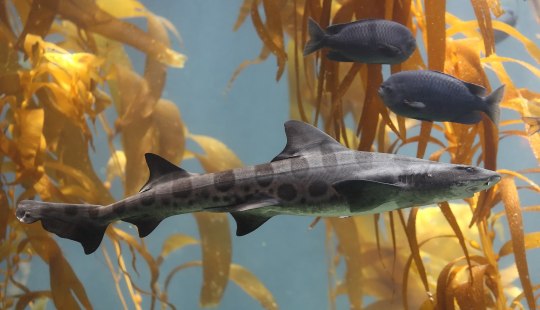
First one's a Zebra Shark (Stegostoma Tigrinum), th' other ones a Leopard shark (Triakis Semifasciata)!
They're pretty docile n' harmless ta humans, but 'm pretty sure there's been some (unconfirmed?) reports of 'em bitin' humans that pull on their tail n shit. So, they can bite 'f provoked, I think.
5 notes
·
View notes
Text
Odysea Aquarium, Scottsdale AZ
Mom took me and my sister to the Odysea last month for my birthday! Sorry I haven't posted sooner but HERE ARE THE PICS!
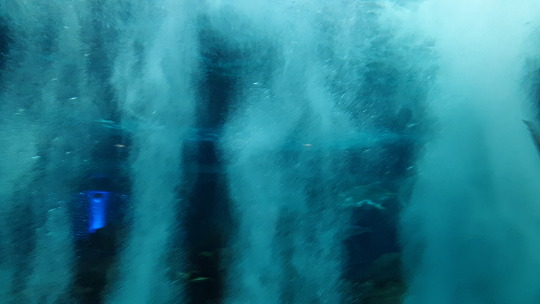
This window over the downstairs bathroom sink was officially voted coolest bathroom in the USA (the plaque said 2017, I think). Why? Because it views into the Voyager shark tank. Trevally, other fish, and FIVE DIFFERENT SPECIES OF SHARKS swim past this window and will even go behind the bubble screen while people are washing their hands. I couldn't get a pic of the sandbar shark when it swam by the window bc it went by pretty quick. But this restroom is by the front entrance and it is the perfect appetizer to a gourmet experience.
Also, trevally are HUGE.

Here is the mascot species of the Odysea, a sand tiger/gray nurse/ragged tooth shark. The bubble fountain at the back of the photo hides the bathroom window.
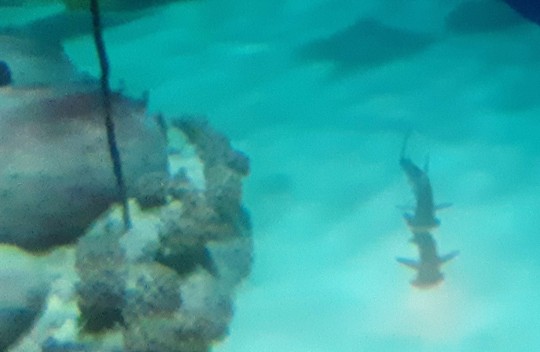
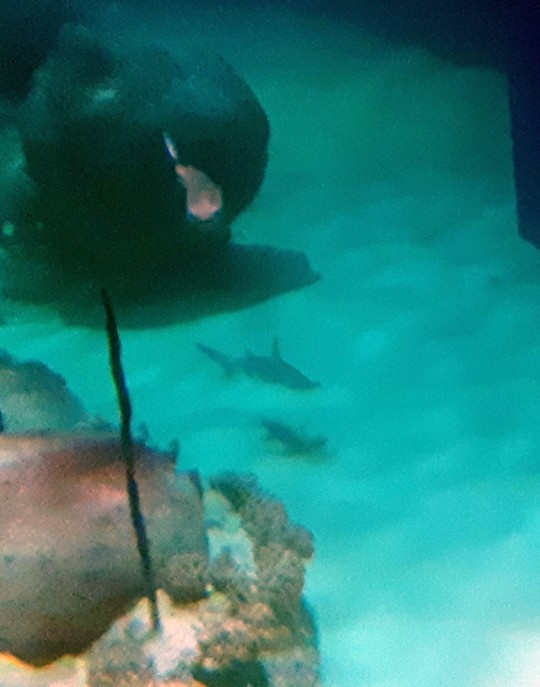
The Sea Trek tank on the upper floor had mostly tropical fish, but it had a zebra shark and A BONNETTHEAD SHARK! SQUEEEEE!!!! Internally crying for joy!!!!
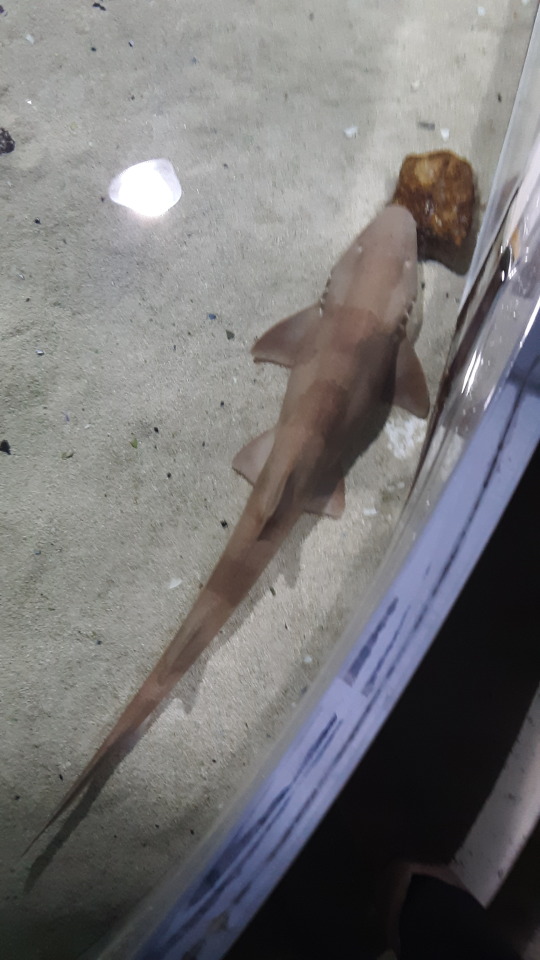
Brown-banded Bamboo Shark in the shark/ray touch aquarium. A couple of times while I was hanging out by this tank I saw it roll onto its side and scratch itself in the sand--I've seen that on video so I jumped whenever I saw it happen. The cownose rays in the touch tanks are absolutely spoiled and swim up to the surface for pets ASAP when they see you approach.
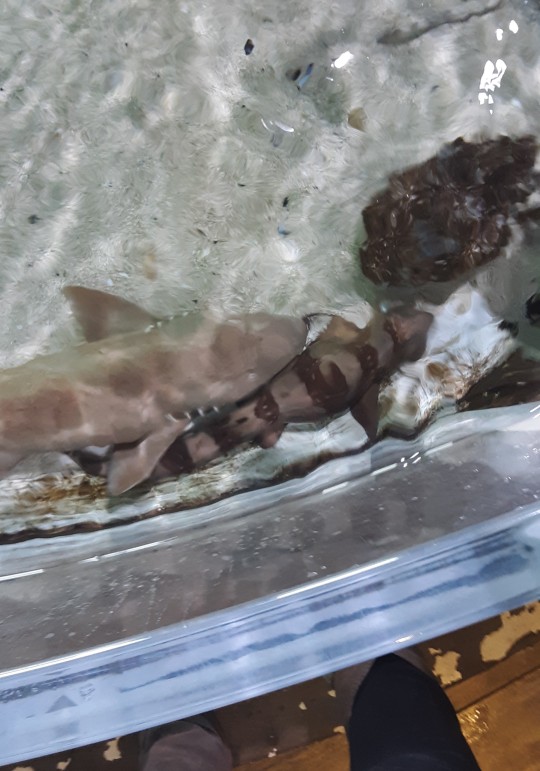
Benthic buddies: here's the brown-banded bamboo shark lying next to the white-spotted bamboo shark.
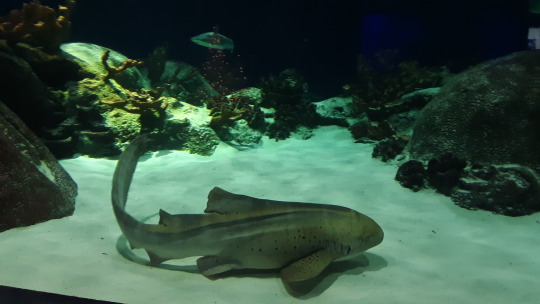
Magnificent zebra shark in the movie theater tank. The movie theater would play 10-minute videos and then move the screen back up between showings. I think this was probably my favorite tank. There was a second zebra shark (Stegostoma tigrinum) in this tank.
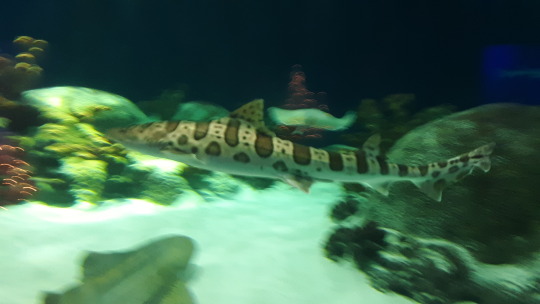
They also had LEOPARD SHARKS (Triakis semifasciata) !!!!!! again, my cup runneth over!
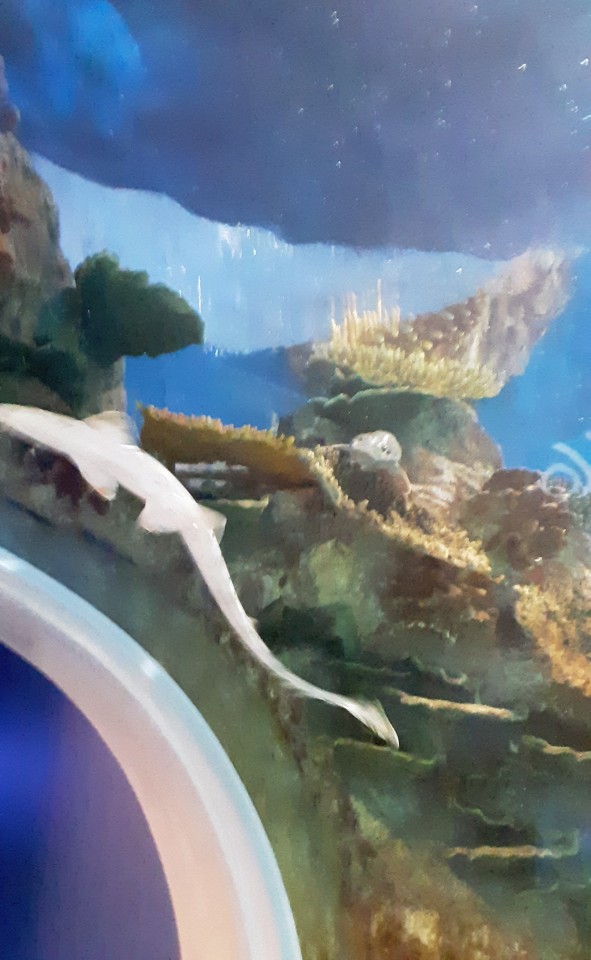
Epaulette sharks in the Great Barrier Reef tunnel. The one laying on the glass was a male and so he was flashing EVERYONE with his claspers (blurry pic--but maybe that's for the better). There was also an epaulette shark in the stingray touch tank.

Got to spend a few moments of shared eye contact with this epaulette shark💖

Back to the Voyager tank. Here is a sandbar shark and the head of a LEMON SHARK. There were at least two lemon sharks in the Voyager tank. It took me a moment to recognize them. The Voyager tanks are kind of dark, and ofc with no natural sunlight the lemon sharks don't get to show off their color properly. Maybe they should change the light fixtures.

Here's a sandbar shark again along with a view of the reef in the Voyager tank. Again, the trevally are ENORMOUS, bigger than the blacktip reef shark (either that, or BTRs are just small). I deliberately avoided taking too many photos and focused more on the experience, so these are just the highlights of the sharks. Also I've seen the giant Amazon rainforest fish before so no need to repeat.
Have some random aquarium denizens:


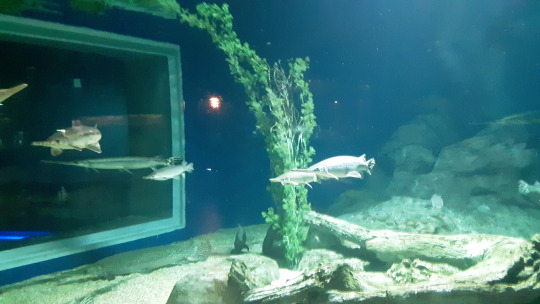
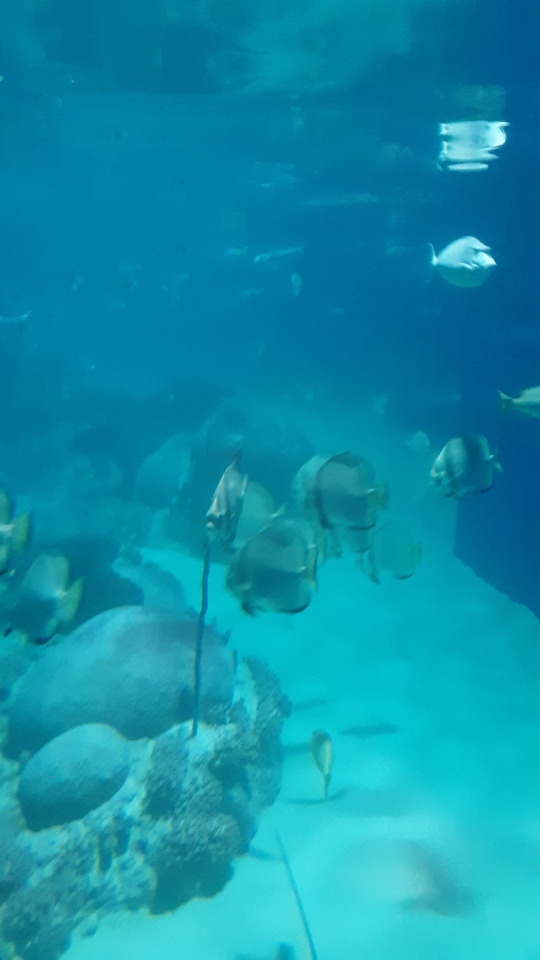
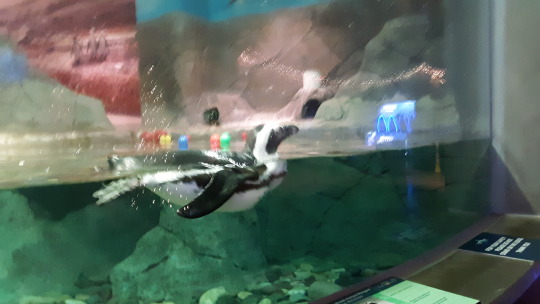
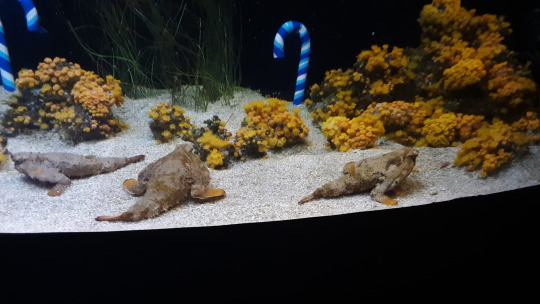
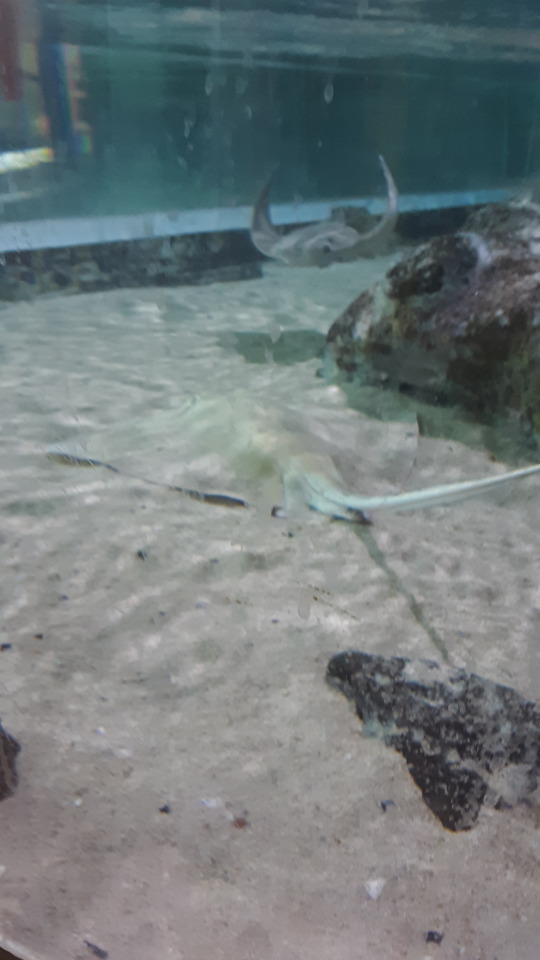
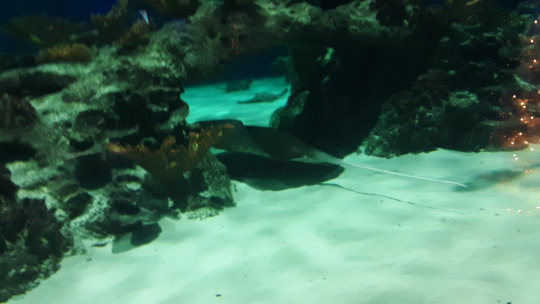
Aquarium review: They definitely put money and effort into making the aquarium a good home for the animals as well as engaging and educational for visitors. I was able to be up close and personal with the sharks, which was exactly what I wanted. I feel like the rotating Voyager exhibit is a little overrated--the cheesy Holiday-themed narration didn't help. Aquarium staff kept their distance but were helpful when needed. Starbucks on the second floor is nice. Super expensive but definitely worth it. 8 out of 10.
#long post#aquarium#aquarium review#leopard shark#zebra shark#epaulette shark#bamboo sharks#white spotted bamboo shark#lemon shark#sandbar shark#bonnethead shark#sand tiger shark#marine animals#penguin#rays#stingrays
21 notes
·
View notes
Text
day 38, 01/03/24 - fish of the day is the leopard shark (Triakis semifasciata)
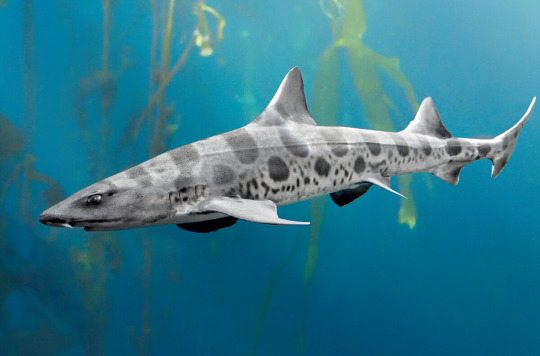
9 notes
·
View notes
Text
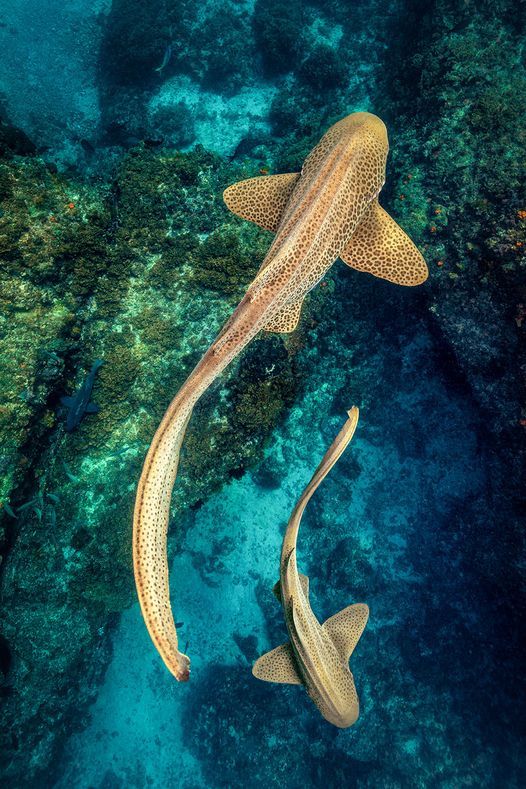
Zebra Shark (Stegostoma tigrinum), family Stegostomatidae, Byron Bay, NSW, Australia
ENDANGERED.
This shark gets its name from the appearance of the juveniles, which are striped.
In parts of its range, it is sometimes called the Leopard Shark. There is, however, another shark referred to commonly as the Leopard Shark. Triakis semifasciata, a kind of houndshark, that lives along the Pacific Coast of North America from Oregon to Mexico.
photograph by Jordan Robins Photography
831 notes
·
View notes
Text
Shark post: some sharks I spotted on my trip to Nausicaá yesterday!
Leopard shark - Triakis semifasciata
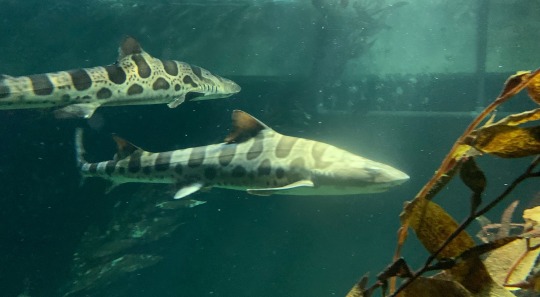
One of my absolute favourite shark species, they are so beautiful and graceful, I spend a good 30 minutes just staring at them, completely enchanted by the way they moved
On average, leopard sharks can grow up to 1,30 meteres. They can live up to 30 years and they grow quite slowly. One of the leopard sharks in the aquarium was significantly smaller than the others, watching him swim alongside the bigger ones was insane!
Starry smooth-hound - Mustelus asterias
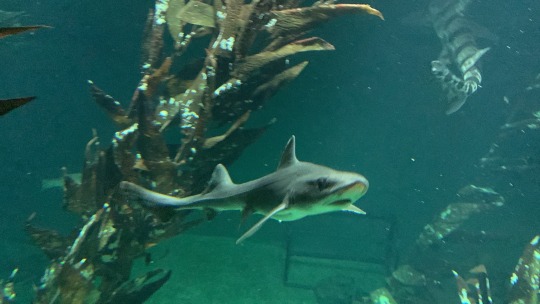
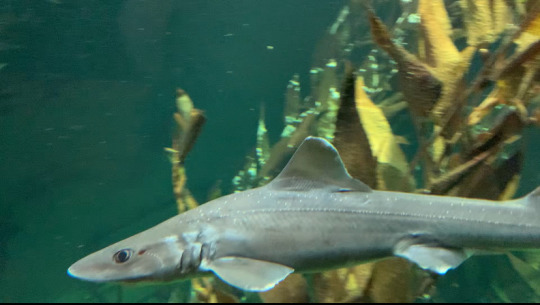
These little guys were sharing a tank with the leopard sharks! On average, they don’t grow larger than 1 meter. A fun fact about them (that I found in my shark book) is that they are viviparous and their nests can be as large as 37 pups! Getting a picture of these little guys was difficult, since the lighting made it hard to get their spots, but these are absolutely gorgeous and I’m obsessed!
Zebra shark - Stegostoma Tigrinum
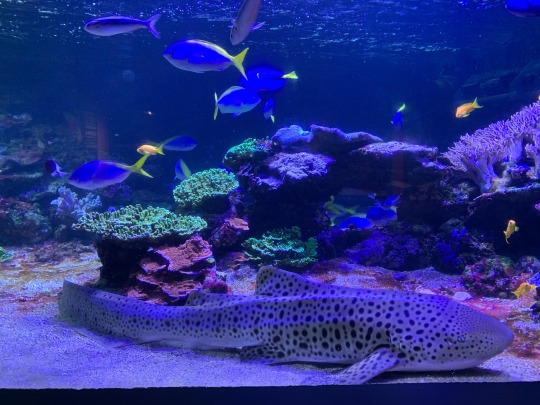
A part of the aquarium was closed for maintenance, and so this one was the only one we got to see. Zebra sharks are also one of my favourites ever! They are oviparous, and the female sharks are able to reproduce with parthenogenesis!
Epaulette shark - Hemiscyllium ocellatum
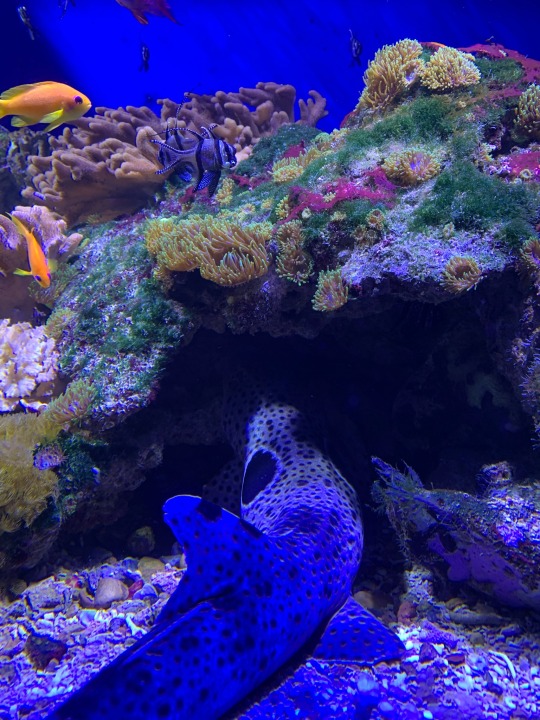
Epaulette sharks are pretty amazing animals! These sharks can use their pectoral fins to “walk” over the seafloor. They have even evolved to be able to walk on land, surviving hypoxia for up to two hours! (This is the best picture of one of them I could get… it was so beautiful)
Sandbar shark - Carcharhinus plumbeus
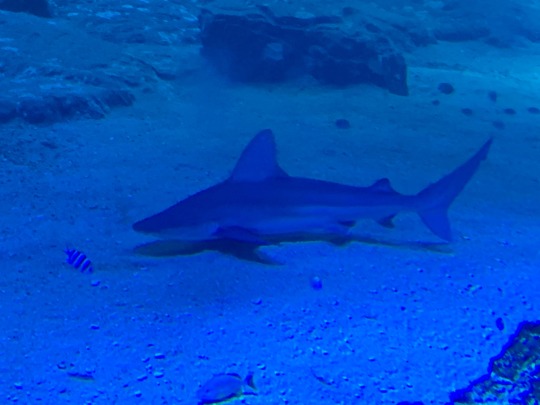
This shark can grow up to almost 2 meters! They are so beautiful when they swim, I loved watching them.
Honorable mention:
small-spotted catshark - Scyliorhinus canicula
These sharks are very commonly found in the North Sea, which is the only sea we have over here in Belgium. I’ve seen this species quite often and saw two of them yesterday, but I didn’t manage to get a picture.
And finally…
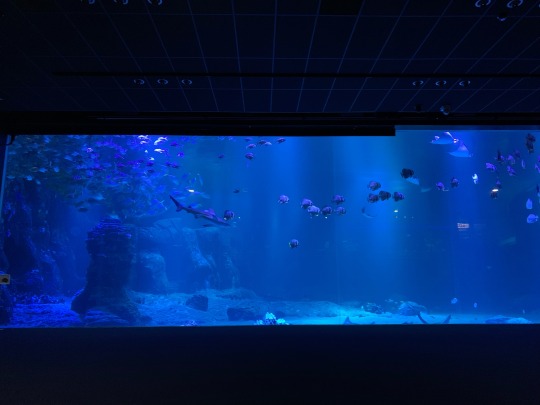
Yesterday was the third time I ever went to Nausicaá. It was, however, the first time that I went outside of school holidays in Belgium and France (where the aquarium is located). And because of this, there was hardly anyone there. And because of that, for the first time ever, I managed to get a clear picture of this aquarium.
The glass is 20 meters long and 5 meters high. In this 54 ton aquarium are half a dozen sandbar sharks, accompanied by many fishes and rays, including a manta ray named Charles (it took me way too long to understand the Ray Charles reference here 🤦🏼♀️).
#shark stuff#epaulette shark#sharks#sharks are the best and you cant change my mind#sharks are cool#leopard shark#zebra shark#nausicaa#sandbar shark#starry smooth hound#marine animals#marine biology#marine life#aquarium
6 notes
·
View notes
Text
2 instances of Carcharodon Carcharias (great white shark)
1 instance of Rhincodon Typus (whale shark)
3 instances of Stegostoma Tigrinum (zebra shark)
1 instance of Triakis Semifasciata (leopard shark)
These creatures are primarily sharks. With the exeption of Rhincodon Typus.
People:”Ew sharks are so ugly and mean and terrifying,their literally the most dangerous thing in the world”
Sharks:


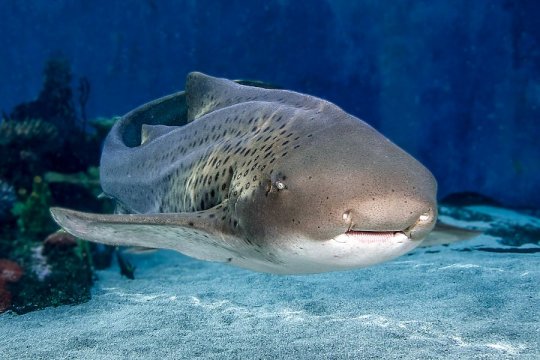
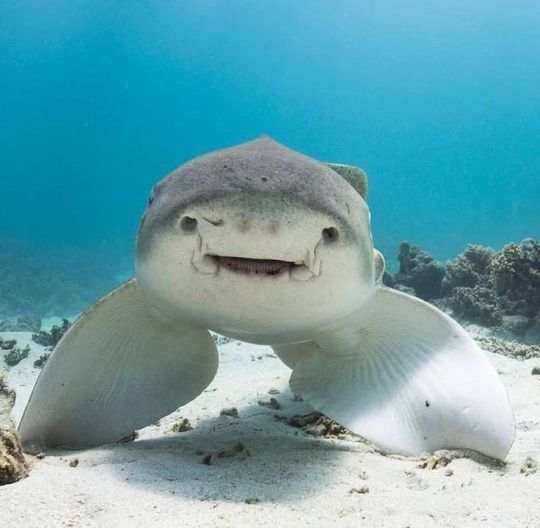

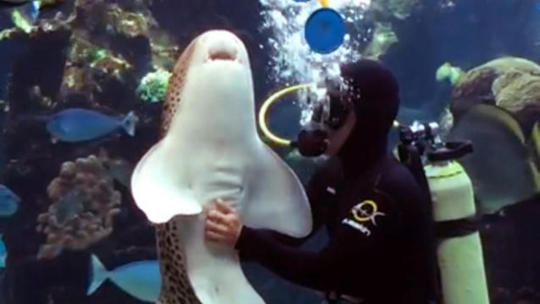

7K notes
·
View notes